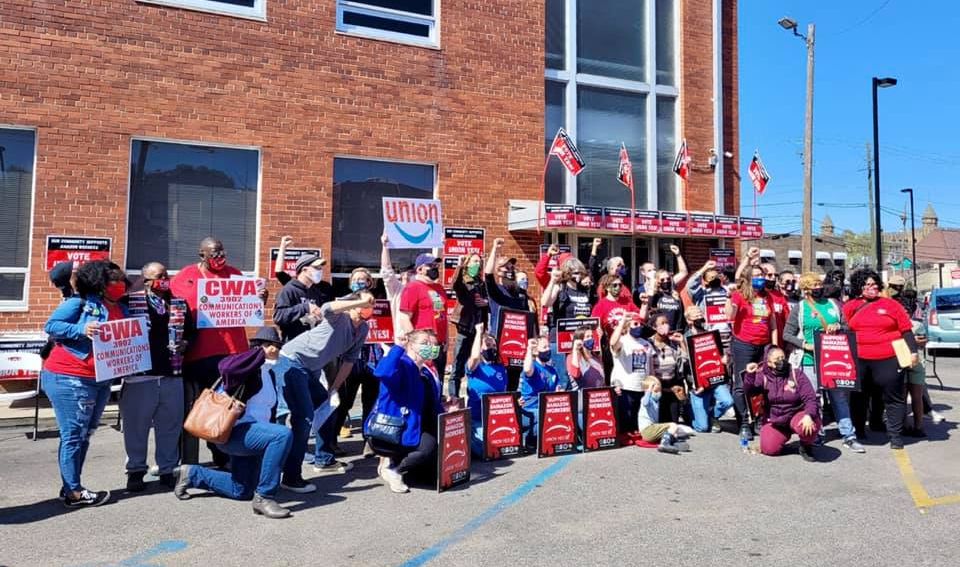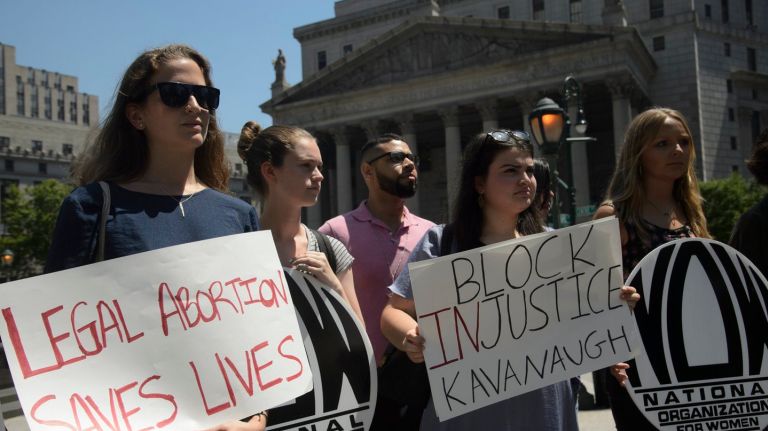Rebecca Green is a member of Socialist Alternative in the US.
Vote counting starts at the end of March, and Amazon will likely use every trick in the book to challenge ballots from union supporting workers to drag the union drive into the courts and delay a final ruling until late April.
The deep south has a long history of voter suppression, one which Birmingham, and Bessemer know too well. Amazon’s tampering and voter intimidation in the union election for a majority Black workforce hits close to home. Reverend William J. Barber of the Poor People’s Campaign speaking about the union drive on March 22 said:
“The union fight and the fight for voting rights and the fight against voter suppression is the same fight. Because all of those fights are fights to bring Black, white, brown, Asian, Native, and poor, low-wealth people together in the south… segregation was a political strategy employed by the wealthy interests of the south to keep the southern masses of Black and white folk divided so that they could keep the labor cheap.”
Amazon’s Dirty Tricks
After months of workers and Retail, Wholesale, and Department Store Union (RWDSU) organizers collecting cards from 1,800 employees at the warehouse to authorize a union vote, they reached the needed threshold to file with the National Labor Relations Board (NLRB) in early January 2021. The NLRB responded saying there were actually 5,800 workers in the warehouse, which came as an enormous surprise. Amazon had expanded the pool of workers in the potential bargaining unit at the last minute by doing the unprecedented: they hired thousands of new employees in a 60-day window. Amazon’s strategy was to dilute the pool and make it harder for the union drive to reach a 51% YES vote. Showing the anger within the workplace and resolve of leading workers, the union collected the necessary cards and filed anyway, kickstarting the campaign.
Amazon then fought to delay the vote. Initially they opposed the union’s demand for a mail-in election amidst a deadly spike in the pandemic, but the NLRB rejected their appeal. As RWDSU staffers and workers stood at the warehouse gates every day, and workers began the process of agitating for a “yes” vote on the shop floor. In the meantime, Amazon hired union busting consultants from the infamous Morgan Lewis law firm to devise their plan. A February disclosure showed that Morgan Lewis was charging Amazon $3,200 per consultant per day.
Once the voting period started, Amazon ramped up a slanderous campaign against the union, urging workers to vote as early as possible in an attempt to guarantee they voted before they had a chance to hear from the union or pro-union workers. Amazon hung massive “Vote” signs in front of the facility, bought massive billboards along the highway to the warehouse, and sent texts telling workers to vote by March 1 – almost four full weeks before the last day workers actually had to mail in ballots.
In the warehouse itself, bathroom stalls and break rooms are plastered with anti-union messaging. Workers are regularly forced to attend captive audience, anti-union brainwashing meetings that employers frequently use during unions drives. In these “meetings” anti-union managers and consultants rail against the union with lies and misinformation. The company even got the city of Bessemer to change the traffic light patterns in front of the warehouse to give union organizers less time to talk to workers coming to and from shifts at the red light.
In the middle of the night, the day after voting started in February, a mailbox mysteriously appeared in the warehouse parking lot. Amazon sent a text claiming that this was installed by the US Postal Service (USPS), but it doesn’t have any USPS markings and the USPS refuses to answer questions or claim ownership of the box. Workers are rightly suspicious. Who has the keys? As with every inch of property Amazon owns, a camera is carefully trained on the mailbox. While many details about the mailbox remain unclear, it has peaked workers’ fear of surveillance and raised more concerns about foul play.
Union Busting Veterans
This isn’t Amazon’s first union busting rodeo. In 2014 and 2015, a drive with the International Association of Machinists and Aerospace Workers to unionize 30 facilities technicians at a warehouse in Chester, Virginia was defeated. Amazon used incessant surveillance of workers, threats, and regularly told workers that it would be futile to vote for the union. While they denied breaking any labor laws, in a settlement with federal regulators Amazon promised they would rigorously obey labor laws in the future. A leading organizer in the drive, Bill Hough, was fired six months later. Corporations like Amazon cannot be trusted to uphold the law, and too often when they do break the law, the only consequence is a slap on the wrist.
Ideally for Amazon, organizing efforts are stopped before they even get to talks about a union. Amazon threatened and retaliated against workers in Queens, New York who opposed the company’s handling of the pandemic last year. They instructed workers to not organize without first notifying the company, interrogated those involved in a walkout, and threatened to discipline anyone talking about the protests on the job.
Union Drive Voter Suppression
The vote count in an NLRB union election works differently from electing a mayor. Under COVID the count will happen via Zoom. Each ballot will be held up and shown to cameras with representatives from both the union and Amazon, concealing only the actual “yes” or “no” vote. Amazon and the union both have the chance to challenge each ballot if signatures don’t look right, bubbles aren’t filled out correctly, or any number of far-fetched reasons that Amazon’s well paid lawyers will argue make the ballot unacceptable. This means that the initial count could drag out as long as two weeks.
Amazon and their anti-union consultants have kept careful track of who supports the union and who is considered “loyal” to Amazon. During anti-union meetings, dissenting workers have had their IDs scanned by the company. Managers are reportedly patrolling the warehouse with clipboards asking workers how they voted. Amazon will likely challenge the ballots of anyone they think will have voted yes using all their thorough data collection and surveillance.
The anti-union lawyers and consultants will aim to drag this process out as long as they possibly can. Amazon is well aware of the national attention and pressure that has been mounting, and the potential for a victory to rapidly rip through other warehouses across the country. Challenging ballots, voter intimidation, and blatantly illegal practices will kick the process to the NLRB. After potentially weeks of the initial count, challenged ballots will then be reassessed and accepted or rejected, which would drag out the process even further into late April.
Amazon’s goal in all of this will be to demoralize workers both in Bessemer and nationally and slow down the momentum that is gathering. We can’t let them get away with this. In the face of Amazon’s union-busting and stalling tactics, our message should be that the fight must continue.
Voter Suppression in Alabama
Alabama, and its Black residents in particular, are no strangers to voter suppression. Alabama brought the lawsuit in 2013 that gutted the 1965 Voting Rights Act; Shelby County, Alabama v. Holder decided that it was unconstitutional to require states to seek clearance for changes in voting laws before adopting them, opening the floodgates for a new round of restrictive laws that specifically suppress the Black vote. Alabama is one of 11 states that does not offer early voting, and one of 11 that requires a witness or notary to sign absentee ballots. After the 2013 ruling, Alabama established restrictive voter ID requirements, closed driver’s license offices and polling locations (disproportionately in majority Black areas), and purged voter rolls.
Slavery, Jim Crow Laws, segregation, and racism were always used by the white ruling class to keep Black and white workers divided and unorganized, thereby keeping labor cheap. This legacy included voter suppression, where the constitutional delegates in Alabama in the early 1900s implemented a poll tax, literacy test, and property requirements to specifically disenfranchise Black and poor white voters. Jeff Bezos and Amazon are continuing in this legacy of capitalist greed that has always seen Black and white workers uniting around shared interests as a fundamental threat to their power.
As Reverend Barber stated, “We told Jeff Clark to call off the dogs on Selma. We need you [Amazon] to call off these union-busting dogs. We need you to call off these union-busting people that you have hired that are trying to stop people from voting. If it’s an insult anywhere, it’s surely an insult in Alabama.”
What is Coming for BAmazon?
Just like the battle for voting rights in the south, winning a union at BHM1 will take a drawn out battle. Amazon was never going to give up easily. In an estimated 54% of union elections with large bargaining units in the U.S. employers are charged with violating federal law. US companies spend around $340 million a year on consultants to crush union drives. Amazon is no different, and if anything, even worse than average.
The union election process itself is always stacked against workers. The same bosses that employ union busting tactics on the shop floors are in the ears of politicians who craft and amend labor law. The NLRB itself is appointed by the President, and right now three out of four members are Trump appointees with no union experience and long corporate resumes.
Trump’s NLRB delayed union elections during the early months of the COVID pandemic, told regional labor board directors to dismiss COVID-related cases, and even ruled that employers have no obligation to bargain over paid sick leave, hazard pay, or temporary pandemic closures. The board also bolstered employers’ ability to change the size of bargaining units, which was explicitly weaponized in the Bessemer Amazon union drive.
The courts, including those overseen by local and national labor boards, have never been favorable terrain for the working class. Laws, both labor and otherwise, were not written by ordinary workers like those at the Bessemer Amazon warehouse, but by the billionaire class and the politicians they control. Worker power and deep organizing on the shop floor will be the key ingredients to overcome unfavorable laws, rebuild the labor movement, take on the bosses, and win.
The most effective strategy to bring this union drive through to a win is to deepen organizing on the shop floor in Bessemer while preparing the ground to, if necessary, go all out to oppose Amazon’s voter suppression. If it is clear when ballot counting starts that Amazon intends to arbitrarily challenge ballots of union supporters and use delay tactics, pressure should be immediately mounted. Protests should be organized at Amazon’s corporate offices first and foremost, followed by actions at fulfillment centers and other Amazon or Whole Foods locations across the country. For this to have the biggest impact on the company and the NLRB, Amazon workers, both in Bessemer and nationally, will need to play the leading role.
Around a hundred union members in LA stormed the offices of Amazon’s union busting firm Morgan Lewis on Tuesday, 3/23 chanting “union busting is disgusting.” This was after a national day of solidarity on 3/20 that saw hundreds of protesters in over 50 cities across the country. This is the type of solidarity that will need to be built on to strengthen the confidence and organization of workers in Bessemer and beyond, and guard against the demoralization Amazon hopes to instill by dragging out the process. Unions around the country should follow the lead of Los Angeles and prepare to go all out in support of Bessemer.
If Amazon is pulling out all the stops to prevent a union “yes” vote, imagine how hard they will fight a first contract if Bessemer workers win a union. Even if workers win union recognition, employers will often fight tooth-and-nail against first contracts for months if not years. They’re not just going to roll over and let union organizing happen in other warehouses, where dozens of workers facing the same horrid conditions have already expressed interest in unionizing.
If this union drive is defeated, we know it was on unfair grounds, and workers should eagerly appeal the decision and call for a new vote. If Amazon wins, we’ll know that Amazon’s bullying over powered the union drive’s reach this round. Worker to worker phone banking, conversations on the shop floor, meetings among workers to discuss strategy, and organizing committees and structures within the warehouse will need to be ramped up even further to cut through Amazon’s lies in round two. Leading workers will face retaliation, and only worker solidarity and collective action can prevent their mistreatment or wrongful termination.
Confidence and optimism from leading workers is crucial. Strong foresight is needed to anticipate and prepare for Amazon’s bullying and the twists and turns to come. The only security workers ever have is the strength of organizing together in the workplace and beyond. To launch a successful contract campaign the internal organizing needs to be matched with strong demands that workers are ready to fight for: like longer break times, $20/hour, overtime for shifts over 8 hours, and an end to “time off task,” which leading workers in the campaign have been pointing to.
If workers win in Bessemer, it will usher in a new era for the American labor movement. But either way the genie is out of the bottle: Amazon, this is just the beginning.



